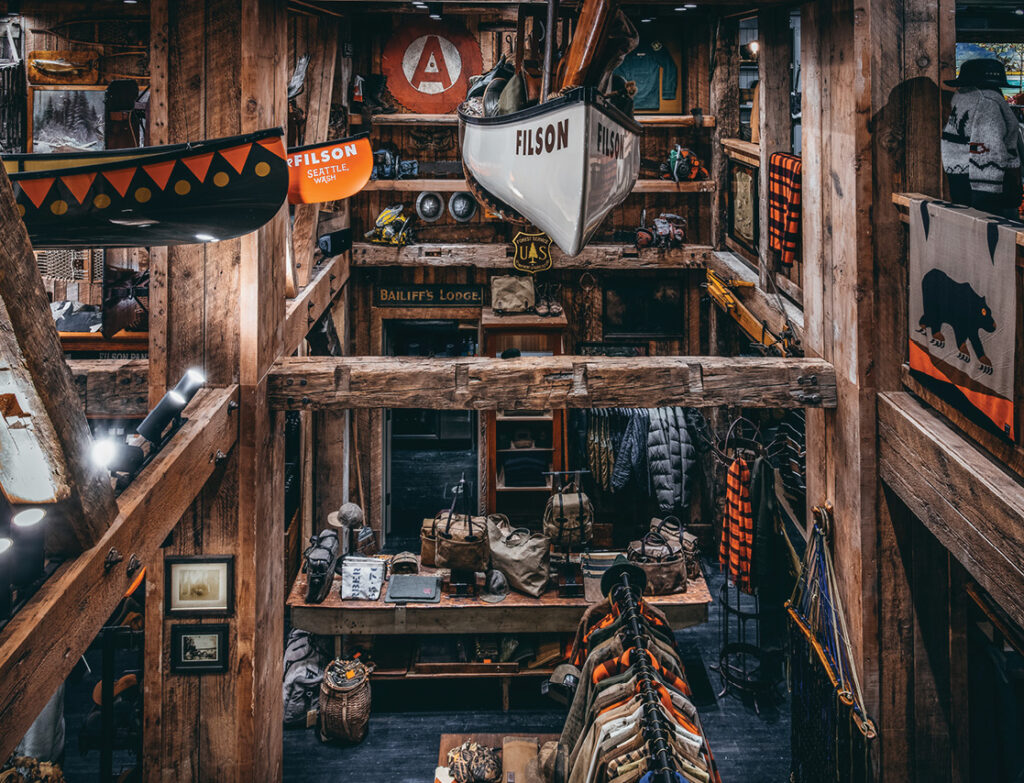During a recent visit to Manhattan, I found myself on Broadway near Union Square following my wife into stores whose names and products are foreign to me and my rudimentary tastes. I left one of those boutiques and stumbled upon a 19th-century brownstone with a sign out front that was a welcome reprieve: “C.C. Filson Co., Alaska Outfitters Since 1897.”
I entered Filson’s 4,000-square-foot flagship store and perused its goods, which are displayed in a multi-level, rustic setting that made me feel like I was home. I recognized boots and jackets that I’ve worn on hunting trips to the Maine woods; I also saw familiar bags I use to haul my gear, pants and shirts that I wear while working on my farm in Virginia.
Filson is known for making “unfailing goods” for outdoor enthusiasts and has earned a reputation for reliability. The sign on the building got me thinking about the brand’s history of accomplishments since its founding—and it’s multigenerational legacy that continues to impact people’s lives.
The sun had not yet risen on July 17, 1897, when the 192-foot S.S. Portland arrived at its berth at Schwabacher Wharf along Seattle’s waterfront. More than 5,000 spectators greeted the steamship, thanks to the efforts of an enterprising reporter who met the vessel at sea to learn more about the cargo and interview some of its passengers. A gathering of welcomers was there to see the precious cargo arrive from the goldfields of the Yukon. In fact, an early edition of the Seattle Post-Intelligencer boldly proclaimed “A Ton of Gold” was soon to arrive in Seattle with “stacks of the yellow metal” confirming vast riches waiting for those daring enough to venture north and stake a claim.
Despite having a dubious reputation from smuggling guns, drugs and illegal workers, the Portland arrived on that July morning with a cargo of more than two tons of gold (the actual measurement was more than double the newspaper’s claim). News of the ship’s riches spread coast-to-coast within days of its arrival, marking the beginning of the Great Klondike Gold Rush. Thousands of industrious people descended upon Seattle, which soon became known as “the Gateway to the Yukon,” in order to secure passage north. Even Seattle Mayor William D. Wood got caught up in the fervor. Wood was in San Francisco attending a conference when he learned of the ship’s haul, and without stopping in Seattle, he promptly telegraphed his resignation and headed to Alaska in search of his fortune.
Thousands of gold-struck travelers stopped over in Seattle on their way to Canada and Alaska, and soon there was a need to clothe and outfit the ill-equipped fortune seekers. Clinton C. Filson, a local merchant, recognized an opportunity and moved his store to downtown Seattle where he could better serve the burgeoning market. By 1898, Filson operated two businesses that catered to the prospectors: The Seattle Woolen Manufacturing Co., and Pioneer Alaska Clothing and Blanket Manufacturers.
Life in the Yukon was harsh. Miners who made their way to the goldfields encountered freezing temperatures, strong winds and driven snow for much of the year. Prospector work was back breaking and often resulted in torn and threadbare clothing. For anyone who made the journey, the difference between cheap and well-made clothing became apparent and often meant the difference between life and death.
Filson understood the importance of supplying dependable and durable goods to his customers, and he quickly developed a loyal following among hardworking laborers. An early Filson advertisement touted: “Mackinaw clothing, Mackinaw blankets and knit goods, as well as, boots, shoes, moccasins and sleeping bags designed specifically for the frigid north.” With a focus on quality, Filson went to great lengths to make certain his wool fabric was made in his own mills.
The Mackinaw Wool that Filson chose for his garments came from the fleece of Suffolk sheep. Raised in the Pacific Northwest, these hardy animals grow a thick coat that protects them from the region’s cold and wet winters. The sheep’s fibers are known for providing long and sturdy fleece; when tightly spun into yarns, the fleece provides great tensile strength, water resistance and breathability—ideal traits for outerwear designed to counter harsh Alaskan winters.
The Yukon Gold Rush died as quickly as it began, and most prospectors returned to Seattle with very few riches. In need of work, many of the former goldminers joined forces with foresters who harvested lumber in the vast timber tracks of the Pacific Northwest. As these foresters traded in their gold pans for double-bit axes, they brought with them a love of Filson gear. Filson soon learned that demand for its Mackinaw wool clothing and other goods—which were able to withstand the rigors of outdoor life and offer protection from the elements—was coming from a new market that was a lot closer to home.
As Filson’s fortunes and reputation continued to grow, its Cruiser jacket garnered the most attention. In the forestry world, a “cruiser” scouts the forests ahead of timber-cutting crews and looks for the harvestable timber. Cruisers had to be quick and nimble as they worked their way through the underbrush and often over steep terrain to find the right trees to fell. The jacket was designed with four large front pockets to hold a timber cruiser’s essentials: compass; notepad; surveying tools. The Cruiser also had a large rear pocket that ran the width of the jacket and included button snaps on both ends for holding maps and charts, which were critically important before the advent of GPS technology. The jacket was offered in Mackinaw wool and in a paraffin, wax-treated cotton material that could withstand thorns and briars. Originally called “waterproof khakis,” today it is known as “tin cloth.”
The Tin Cloth Cruiser became very popular and was regarded as an innovation. In 1914, Filson applied for and was granted a U.S. patent on the product. The Cruiser developed a legacy during the last century, one that is steeped in history. While the jacket has gone through iterations over the course of its lifetime, the design never strayed too far from its roots and has earned a dedicated following among hunters, anglers and outdoorsmen across the globe. It remains one of the company’s most popular items.
Like the Cruiser jacket, Filson too has gone through many iterations over the course of its 125-year history. Today Filson’s retail stores are found in Seattle and in select cities, including San Francisco, Tokyo, Toronto, our nation’s capital—and thankfully here in Manhattan, where I enjoyed browsing and making my way through the store.
Here in New York, I imagine many shoppers may select a jacket that will never shoulder a shotgun or buy boots that will never venture off the pavement. But that’s okay, and I began to understand the true legacy that Clinton C. Filson created 125 years ago. It is based on quality, dependability and functionality. The goods the company makes are often handed down to other generations. These goods are not meant for a single pursuit and appeal to many. The company motto “Might as well have the best” is embedded in the products it makes. While tastes may have changed since Filson was founded in 1897, providing the best will never go out of style.
Eric Kallen is editor-at-large of The Virginia Sportsman.
its 125th Anniversary
















